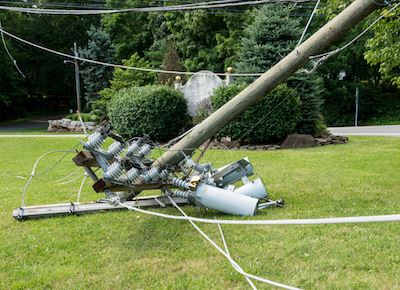They blend into our surroundings. If they’re close to your home, chances are you don’t see them at all. What are they? Utility poles.
Electricity is an important part of our daily lives. It’s also extremely dangerous. If you have a utility pole near you, it’s important to keep your distance. If a downed power line occurs nearby, stay away from the area and contact the proper authorities immediately.
But what about a utility pole is dangerous?
Let’s start with the facts.
A utility pole is typically 35 feet tall, though it can range anywhere from 20 to 100 feet, depending on the conditions. They are usually made from Douglas fir, southern pine, or western cedar oak, and can last up to 40 years. Recently, we’ve been converting to utility poles made from concrete, steel or fiberglass, which can last much longer. The poles are buried 6 feet into the ground and spaced about 125 feet apart.
A utility pole will connect and carry different types of wires and connections. They include:
- High voltage transmission wires carrying up to 500 kilovolts as it makes its way to substations where the voltage is reduced
- Distribution wires that carry newly reduced power (up to 25 kilovolts) into homes and businesses
- Communication lines that bring cable television, broadband, and telephone into homes and businesses
- Transformers that convert high voltage into low voltage
While you should never approach a utility pole and teach your kids to keep their distance at all times, certain circumstances can increase the danger.
Leaning Poles – because most utility poles are made from wood, they are susceptible to environmental conditions such as heat, cold, ice, snow, wind, etc. They are also susceptible to insect damage. If they lean too much, they may crack and break off, causing the transformer to come crashing to the ground.
Power Lines – if the utility poles fall, they bring power lines with them. These power lines typically carry between 4 to 25 kilovolts, enough to cause severe injuries or even death. You don’t have to touch the wire; tree branches that come in contact with power lines can energize the tree and the ground around it, making the entire area hazardous.
Ground voltage – as the wires connect with the ground, electrical currents can travel through soil and into metal objects on the surface. This includes things like streetlights, fire hydrants, manhole covers, etc. Simply touching these surfaces can release an electric shock into your body.
Chemicals – utility poles are treated with preservatives before they are installed to help them last longer. These chemicals pose health problems to both humans and animals.
Have further questions about utility poles or electrical wires in or around your home? Give us a call today.

